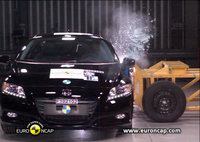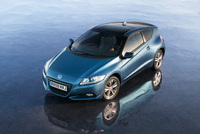Honda CR-Z Achieves Top Euro NCAP Overall Safety Rating - VIDEO ENHANCED
 |
SEE ALSO: Honda Buyers Guide
LONDON - August 26, 2010: The Honda CR-Z has been rated one of Europe‘s safest cars, following on from the success of the Honda Insight, according to the new independent crash testing results from Euro NCAP.
Euro NCAP’s rating scheme focuses on the vehicle’s overall safety performance which gives consumers an easy to understand single score. The system considers occupant protection in frontal, side, pole and rear impacts, child protection, pedestrian protection and the availability of driver aids. The Honda CR-Z has been awarded the maximum 5-star rating.
Click PLAY to watch the CR-Z crash test video
The new rating scheme, introduced in February 2009, uses a weighted score, combining many aspects of a car’s safety performance: adult (50%), child (20%) and pedestrian (20%) protection assessment results with the availability of safety assistance devices (10%). To qualify for inclusion, safety assistance devices (VSA for Honda) must be fitted as standard across 90% of the EU 27 2010 model range.
The CR-Z is the most recent in a string of Honda cars to receive top marks.Since the introduction of the new rating scheme Euro NCAP have tested 4 other Honda models; Civic, Accord, Jazz and most recently, Insight. All 5 models achieved 5 stars, with the Honda Insight also being named “safest hybrid vehicle” as well as the 2nd safest vehicle tested in 2009.
Euro NCAP's new assessment reflects Honda’s commitment to overall vehicle safety, complimenting Honda’s long standing in-house safety testing which seeks to improve real world safety. Honda’s car-to-car crash test facility at the Tochigi R&D centre analyses impacts between models of different sizes and weights and develops solutions to mitigate injuries for both for passengers and pedestrians. The omni-directional vehicle-to-vehicle crash test facility opened in 2001 and is the world's first indoor all-weather facility of its type.
Safety in the Honda CR-Z
Vehicle Stability Assist
Vehicle Stability Assist (VSA) is designed to assist the driver in
maintaining control during cornering, acceleration and sudden manoeuvres by
applying braking assistance to any of the wheels as necessary and
modulating the engine torque output as required.
Braking
14" ventilated front and solid rear disc brakes ensure road stability,
which is further enhanced by the Anti-lock Braking System (ABS), Electronic
Brake-force Distribution (EBD) and Brake Assist (BA).
Advanced Compatibility Engineering (ACE)
Developed in the car-to-car crash testing facility at Tochigi, the
Advanced Compatibility Engineering™ (ACE™) body structure is
now a well-established strength of Honda’s safety credentials.
The ACE™ body structure is a Honda exclusive body design that enhances occupant protection and crash compatibility in frontal collisions. The ACE design utilises a network of connected structural elements to distribute crash energy more evenly throughout the front of the vehicle. This enhanced frontal crash energy management helps to reduce the forces transferred to the passenger compartment and can help to more evenly disperse the forces transferred to other vehicles in a crash. Pedestrian Protection
The CR-Z also incorporates many features designed with pedestrian-protection in mind. Research has shown that these features can dramatically improve a pedestrian's chance of survival if struck by a moving vehicle. Features include windscreen wiper pivots designed to break away on impact, energy absorbing front wing mounts and bonnet hinges, as well as an unobstructed area beneath the bonnet allowing greater space for deformation.
Airbags and Seatbelts
On all models the driver and passenger Supplemental Restraint System
(SRS) front and side airbags are complemented by full length curtain
airbags to protect all occupants. There are three-point Emergency Locking
Retractor (ELR) seatbelts in all seating positions, the front seatbelts
also have 2 stage Energy Absorption (EA) load limiting pretensioners.
Additionally in the rear ISOFIX points ensure secure and correct
installation mounting of child seats.
Active headrests
The CR-Z is equipped with front seat active headrests which reduce the
likelihood of neck injury in rear impacts. As the occupant is pushed
against the seat back, a rigid plate in the seat presses a link to the
headrest pushing it up and forward to support the head.
About the CR-Z
 |
The Honda CR-Z is a unique new car, combining the advantages of a clean, efficient petrol electric hybrid powertrain with a 6-speed manual transmission and a stylish coupe body.
Click PLAY to watch the CR-Z promo video
The CR-Z is the first car to combine a 1.5-litre i-VTEC engine and the IMA system, giving excellent fuel economy and great emphasis on driver enjoyment. The CR-Z emits just 117 g/km of CO₂ on the EU test cycle and consumes just 5.0 l/100km of fuel.
Three Mode Drive System
The CR-Z has been designed to be a car that combines driver enjoyment
with excellent urban driving performance and economy. Honda’s
engineers have developed the 3-Mode Drive System for the CR-Z, which allows
the driver to alter the characteristics of the car depending on their needs
and the environment the car is being driven in. By significantly altering
the responses of the car, the CR-Z’s new system allows drivers to
adapt to different road and traffic situations.
The new feature enables the driver to choose between three driving modes which alter the responses of the throttle, steering, climate control, Idle Stop function and the level of assistance provided by the IMA system. In developing this new facility, Honda allows the driver to decide whether they wish to maximise sportiness, economy or the best balance between the two.
SPORT Mode
When the CR-Z driver is away from the town or city and wanting to enjoy
the open road, they can put the car into SPORT mode. This sharpens the
throttle response, changes the behaviour of the IMA hybrid system to
provide more electric motor assistance and increases the weight of the
electric power steering.
ECON Mode
ECON mode prioritises fuel economy in the operation of the drive-by-wire
throttle, ECU, air conditioning and the hybrid system. For those times when
spirited driving is not possible or desirable, the Eco Assist function, in
conjunction with the ECON mode, allows the driver to enjoy beating their
best economy score on the way to work, or in heavy traffic.
The ECON mode reduces the sensitivity of the throttle to smooth out inputs and this action is assisted by the use of a different engine map that prioritises fuel economy. The use of the motor to assist the petrol engine is redefined with the priority given to improve fuel economy, not assist performance.The climate control system is also influenced by the ECON mode, by recirculating air and reducing compressor operation in order to reduce energy consumption. In this mode the Idle Stop parameters are dramatically increased which extends the time spent with the engine off.
NORMAL Mode
At all times the car can be run in NORMAL mode, which provides a balance
between performance, economy and emissions and suits most driving
situations.


